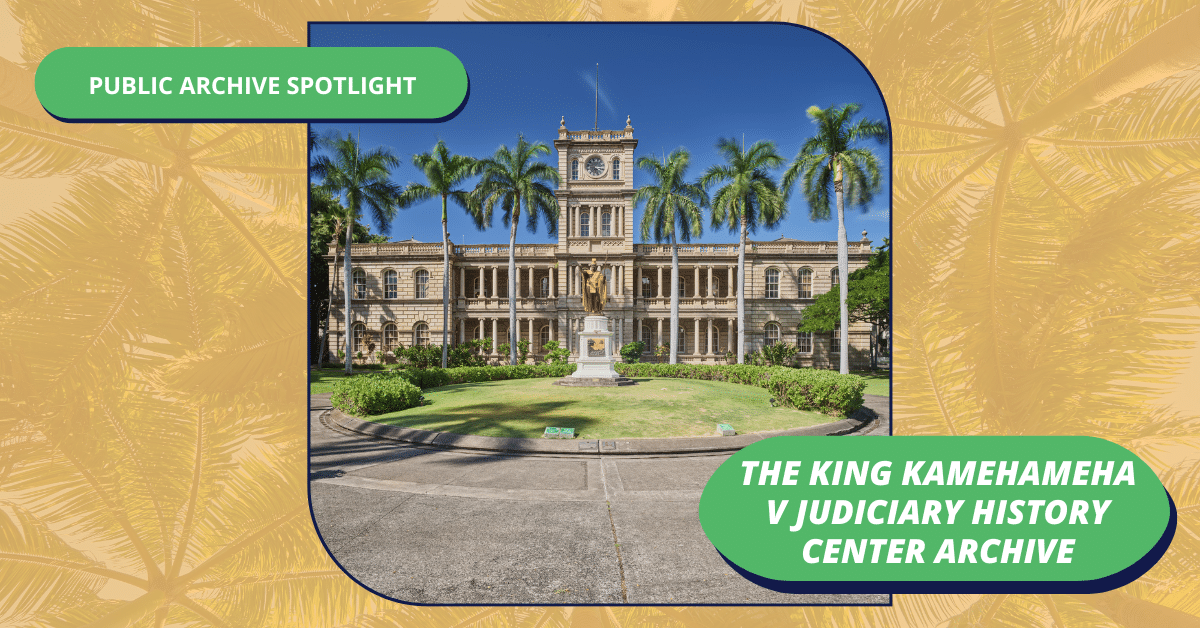
This month, we are delighted to announce the public unveiling of the King Kamehameha V Judiciary History Center Archive. As one of our Byte4Byte partners, the Center has worked tirelessly to make their collections accessible through a digital archive on Permanent. Keep reading to learn about the creation and value of this archive, which holds significant educational and historical benefit for current and future generations. Throughout this blog, you will find items from the Center’s collection that capture its rich history.
We spoke with Brieanah Gouveia, the Curator of Collections & Programs, who shared with us some information about the Center and their collections on Permanent. She explains that the collection houses records “from the early 1800s to present day” that pertain to Hawaiʻi’s civic and legal history. According to Brieanah, these extensive archives capture “significant people, institutions, and events connected to Hawaiʻi’s courts and legal community, that shaped law, public policy and government over the last 200 years.” Additionally, they illuminate how “Native Hawaiian structures, values, and lives adapted to, borrowed from, or clashed with Euro-American influences, creating the hybridized legal system and social institutions that characterize the State of Hawaiʻi today.” Through the archive, the Center is able to ensure access to the rich history of the Hawaiian people.
Our Byte4Byte program aims to ensure that future generations have access to the diverse and vibrant legacies of past and present individuals, organizations, and movements in your communities. The King Kamehameha V Judiciary History Center exemplifies this goal by shifting the historical paradigm and uplifting historically marginalized narratives for social good.
In addition to archival storage, the Byte4Byte program can also provide intern support to help achieve project goals. The interns are typically archival students in need of hands-on experience in digital archiving, who are also interested in community archiving practices. Our Community & Partnerships Manager, Amanda, collaborated with Brieanah to define the intern’s project scope, draft a job description, interview candidates, and eventually onboard Morgan Schmidt, who worked to establish an archival workflow for the Center. Morgan explained that while the Center holds “extremely culturally and historically valuable materials,” the archive is not widely known within Hawaii. With a digital archive on Permanent, Morgan explains that it “allows for easier and more widespread patron access, as well as increasing awareness of JHC’s collections.” During the internship, Morgan researched “professional standards and guidelines” to create a workflow for adding future items to the Center’s collection on Permanent.

For those unfamiliar, we’d like to share some historical context about Hawai’i written by Brieanah:
“By the 1850s, the Hawaiian Kingdom was one of the most literate nations in the world. Native Hawaiian leaders revolutionized the indigenous systems of governance and societal structure, infusing them with western institutions and ideals, establishing Hawaiʻi as an independent, sovereign constitutional monarchy. Aliʻiōlani Hale, located in downtown Honolulu, was the capitol building of the Hawaiian Kingdom from 1874 until its illegal overthrow by the US in 1893. Since 1874 through today, Hawaiʻi’s Supreme Court has operated in Aliʻiōlani Hale. Alongside the Supreme Court, the King Kamehameha V Judiciary History Center preserves material culture pertaining to the legal and judicial history of Hawaiʻi.”

Establishing a digital presence was crucial for the King Kamehameha V Judiciary History Center to ensure accessibility to their collection. Brieanah explained that access to the archives “is greatly limited due to geographic and economic factors facing residents across the State of Hawaiʻi, as well as stakeholders who may have moved off-island due to rising costs of living.” With the creation of a public archive on Permanent, Brieanah feels that the new online public archive access is not only an invaluable resource to Hawai’i’s community, but also in “sharing Hawai’i’s civic story with the larger, global internet audience.”

When it comes to historical narratives, stories are often told by those who had enough money or power to make their stories heard. We believe that all voices deserve to be not only heard, but preserved as well, to help reshape the historical narrative to capture a fuller picture of the past. With their archive, the Center hopes that “people understand that Hawaiʻi was not quickly conquered and changed by Euro-American imperialism due to a passive native community.” This harmful narrative, which has dominated our historical memory, is proven false by the records in the Center’s archive.
Brieanah shared that rather than being a passive community who readily accepted the colonizing forces, “Hawaiians adapted western institutions and tools, such as written law and the court system, creating a thriving and progressive constitutional monarchy that secured international sovereignty and power for their people and land for almost a century before the actual overthrow of the Hawaiian Kingdom.” This corrects the long-told narrative, but it also highlights the civic importance of the Hawaiian people and their adept skill when facing colonization. Brieanah explained that the Post-Kingdom records in the collection evidence “the continuous change and adaptation that Hawaiʻi’s hybridized system of law and governance has experienced to present day, and which significantly shape the lives, relationships, and power struggles between the different native and non-native communities that make up the State of Hawaiʻi’s diverse population.” We invite you to view their collection and learn more about Hawai’i’s civic history and its impact on Hawaiʻi today.
If you would like to learn more about our Byte4Byte program or to apply on behalf of your non-profit, please visit our grant application page. We accept applications year-round, with our next cohort deadline on October 2nd, 2024. Thank you again to the King Kamehameha V Judiciary History Center for entrusting us with their archive.
- Byte for Byte (6)
- Community (32)
- Control (5)
- Events (3)
- Everyone's An Archivist (10)
- FamilySearch (2)
- Holidays (6)
- Legacy Lab (4)
- Metadata (2)
- Milestones (4)
- Mobile Apps (2)
- Our Features (22)
- Our Team (9)
- Partnerships (9)
- Preservation (41)
- Publish (7)
- Reflections (10)
- Technology (12)
- Uncategorized (7)
- When Disaster Strikes (3)
- AAPI (3)
- AAPI Heritage (3)
- Accessability (1)
- Accessibility (2)
- Activity (2)
- African American (11)
- African American History (1)
- African American History and Culture Museum (1)
- AI (4)
- ALA (1)
- ALA Conference (1)
- ALAAC21 (1)
- Amanda Gorman (1)
- Amberly Russell (1)
- American History (5)
- American Indians in Texas (1)
- American Library Association (1)
- Ancestors (6)
- Ancestral Healing (1)
- Ancestry (5)
- Antebellum Era (1)
- Architectural History (1)
- Architecture (1)
- Archival (2)
- Archive.org (1)
- Archives (6)
- Archiving (1)
- Archivist (1)
- Artificial Intelligence (1)
- Baltimore (1)
- Basics (4)
- Beginners (1)
- Beginning (4)
- Black (1)
- Black History (11)
- Black History Month (8)
- Book Talk (1)
- Boston Tea Party (1)
- Brick Walls (3)
- Bryson Williams (1)
- byte4byte (8)
- Caribbean (1)
- Cemetary (1)
- Cemeteries (1)
- Cemetery (1)
- Census (2)
- Children (2)
- Children's Activity (1)
- Chinese (2)
- Citations (1)
- City Directories (1)
- Civil War (4)
- collaboration (2)
- Community (1)
- Community Archive (2)
- Community Archiving (1)
- conference (2)
- Context (2)
- Cooking (2)
- Creative (4)
- Creativity (1)
- Cultural Competency (1)
- Cultural Heritage (2)
- Danny Trejo (1)
- data privacy (2)
- Database (1)
- David Copperfield (1)
- Death (2)
- Death Records (2)
- DEIA (1)
- Digital Accessibility (2)
- Digital Archiving (3)
- Digital Estate Planning (2)
- Digital Humanities (1)
- Digital Legacy (1)
- Digital Preservation (2)
- digitization (7)
- Digitizing (1)
- Disability (1)
- Discussion (2)
- Diversity (1)
- DIY (1)
- Downsizing (1)
- Education (1)
- elon musk (1)
- Emigration (2)
- endowment (1)
- Equity (1)
- Escape Room (1)
- Estate Planning (1)
- Etherpad (1)
- Excel (1)
- Facial Recognition (1)
- Family (2)
- Family Activity (1)
- Family Archive (2)
- Family history (54)
- family history month (1)
- Family Patterns (2)
- Family Photos (1)
- Family Reunion (1)
- Family Secrets (1)
- family stories (2)
- FamilyHistory (11)
- Fashion (2)
- Fashion History (1)
- Film Negatives (1)
- Find a Grave (1)
- FOIA (1)
- Food History (4)
- Foreign Records (1)
- Forgiveness (1)
- gallery (1)
- Games (1)
- genealogy (63)
- Gifting (1)
- GPS (1)
- grants (1)
- Graves (1)
- guest post (1)
- Handwriting (2)
- Hispanic Heritage (1)
- Historic American Buildings Survey (1)
- Historical Fashion (1)
- History (13)
- Holidays (2)
- Homes (1)
- Human Rights (1)
- Illness (1)
- Immigration (2)
- Inclusion (1)
- Indigenous (1)
- Indigenous Heritage Month (3)
- Indigenous History (3)
- Internet Archive (1)
- Interviewing (1)
- Jewish History (1)
- Jim Crow (1)
- Kids (4)
- Land (2)
- Latinx Heritage (1)
- Laws (2)
- Learning (1)
- Legacy Contact (1)
- Legacy Lab (1)
- Legacy Planning (2)
- Legal (2)
- Letters (1)
- lgbtq (2)
- lgbtq history (1)
- LGBTQIA (2)
- LGBTQIA History (1)
- Library of Congress (3)
- Literature (1)
- Local History (6)
- Maps (2)
- Marriage (1)
- mastodon (1)
- member spotlight (2)
- Member Success (1)
- Memoir (2)
- Memories (27)
- Memory (4)
- Memory Care (1)
- Memory Forward (1)
- Memory Work (1)
- Metadata (3)
- Metadata Working Group (1)
- Methodology (9)
- Mexico (2)
- Migration (2)
- military (5)
- Military History (4)
- Mission (1)
- mobile apps (2)
- Mysteries (1)
- NAHM (1)
- Native American (1)
- New Orleans (1)
- Newspapers (1)
- Novel Records (1)
- Obama (1)
- OCR (1)
- open source (4)
- Oral History (1)
- organization (2)
- Organize (1)
- Organizing (9)
- Orientation (1)
- Pandemic (1)
- Photo Managers Conference (2)
- Photo organizing (2)
- Photography (3)
- Photos (23)
- ponga (1)
- postcard archive (1)
- postcards (1)
- Preservation (23)
- Preservation Services (1)
- Preservation Week (1)
- Probate Records (1)
- Problem Solving (2)
- product updates (4)
- Professional Development (1)
- Project (1)
- ProjectKin (2)
- public archive (4)
- public archive spotlight (9)
- Public Gallery (4)
- Publish (5)
- Recipe (2)
- Recipes (1)
- Records (18)
- Religion (2)
- Reminiscence Therapy (1)
- Repositories (3)
- Research (8)
- Research Trip (1)
- Resilience (1)
- Resources (1)
- Reunion (1)
- roadmap (1)
- Robert Friedman (3)
- RootsTech (4)
- RootsTech 2024 (4)
- Safety (1)
- Sanborn Maps (1)
- Savemetadata.org (1)
- Scanning (1)
- Scavenger Hunt (2)
- Search Techniques (1)
- Share and Publish (11)
- Sharing (4)
- Social Clubs (1)
- Social History (6)
- Sociology (1)
- softwaredevelopment (1)
- softwareengineering (2)
- Sources (1)
- spotlight (3)
- staff spotlight (2)
- storage grant (1)
- Stories (18)
- StoryCorps (1)
- storytelling (12)
- Suffragettes (1)
- sustainability plan (2)
- sustainable organization (1)
- Tax Records (1)
- Taxes (1)
- technology (14)
- Thanksgiving (1)
- The Photo Managers (1)
- Timeline (1)
- Tools (7)
- traditions (4)
- Trans History (1)
- Transcribing (1)
- Translating (1)
- Translation (1)
- Trip (1)
- Truth (1)
- twitter (1)
- twittermigration (1)
- ui/ux (1)
- Veterans Day (2)
- Videos (1)
- Volunteering (1)
- webinar (1)
- Website (1)
- Websites (5)
- West Indies (1)
- wikipedia (1)
- Wills (1)
- Women (11)
- Women's History (1)
- Workshop (10)
- Writing (7)
- Writing Club (1)
- WW1 (1)

